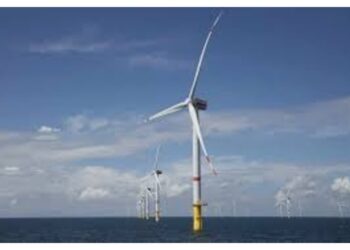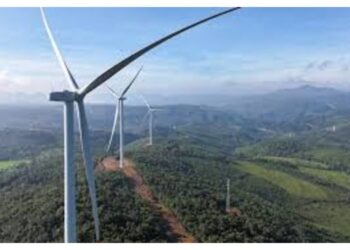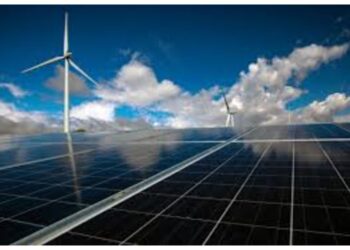The global floating wind turbines market is set for explosive growth as the world transitions away from fossil fuels towards renewable energy. Valued at US$ 4.9 billion in 2023, the market is projected to skyrocket to US$ 83.4 billion by 2034, expanding at an impressive CAGR of 29.4% during the forecast period. This blog delves into the drivers behind this robust growth, the technological advancements shaping the sector, and the regional dynamics that position Europe as the current leader, while also spotlighting the innovative players driving the industry forward.
A New Era in Offshore Wind Energy
Floating wind turbines represent a groundbreaking solution in offshore wind energy. Unlike traditional fixed-bottom turbines, these turbines are mounted on floating platforms that are anchored to the seabed. This design allows for deployment in deep waters where wind resources are often stronger and more consistent, significantly broadening the potential for offshore wind development.
There are several types of floating wind energy systems, each tailored to different marine conditions:
- Spar-buoy Foundations: These structures are essentially cylindrical bodies that are ballasted to ensure the center of gravity remains below the center of buoyancy, reducing critical wave-induced motions.
- Semi-submersible Foundations: Comprising multiple columns and pontoons, these platforms are popular due to their stability and feasibility in supporting floating turbines.
- Tensioned Leg Platform (TLP) Foundations: These are designed with vertical tie wires anchored to the seabed, providing enhanced stability in rough marine environments.
Advancements in turbine design, coupled with improved engineering in mooring and anchoring systems, are making these platforms more efficient and cost-effective, thus accelerating their adoption.
Key Drivers of Market Growth
Reduction in Fossil Fuel Dependency
One of the foremost drivers behind the floating wind turbines market is the global push to reduce fossil fuel dependency. As governments and industries around the world strive to mitigate climate change and reduce carbon emissions, renewable energy sources have taken center stage. The shift away from coal, oil, and natural gas towards wind and solar power is not only a response to environmental concerns but also a strategic move to ensure long-term energy security.
Recent data from the U.S. Department of Energy highlights that the U.S. generated 52,687 MW of offshore wind energy in 2023, marking a 15% increase from 2022. This surge reflects the growing confidence in wind power as a reliable and sustainable energy source. Floating wind turbines, in particular, offer the flexibility to harness wind energy in regions previously inaccessible to traditional turbines, further accelerating the transition to renewables.
Increase in Funding for Environmentally Friendly Floating Wind Farms
Government investments and increased funding for sustainable energy projects are crucial in driving market expansion. With a heightened focus on limiting carbon emissions, stakeholders are channeling significant resources into developing environmentally friendly floating wind farms. These projects not only contribute to the reduction of greenhouse gases but also support economic growth by creating jobs and fostering innovation in renewable energy technologies.
A notable example is the Floatfarm project, initiated in January 2024 by a consortium of 17 partners across eight European countries. Funded by the European Commission with nearly EUR 6 million, this project aims to mitigate the environmental impacts of offshore wind farms on marine life while boosting public acceptance. Similarly, projects like the BATSO initiative in France, funded by the French Environment and Energy Management Agency, underscore the commitment of European nations to transform their energy landscape sustainably.
Technological Advancements and Market Trends
Breakthroughs in Turbine and Foundation Designs
Technological innovation is at the heart of the floating wind turbines market. Improved turbine engineering, better aerodynamic designs, and advanced control systems are increasing the efficiency and reliability of wind turbines. Enhanced designs are also contributing to the growth in turbine capacities, allowing for greater energy capture from offshore wind resources.
On the foundation side, the development of spar-buoy, semi-submersible, and TLP foundations has revolutionized the deployment of wind turbines in deep-water environments. These systems are designed to distribute the turbine’s mass effectively and reduce installation costs—an essential factor in the large-scale implementation of floating wind projects.
Integration with Smart Grid Technologies
The integration of floating wind turbines with smart grid technologies is another trend that is propelling the market forward. By linking offshore wind farms to digital monitoring and control systems, operators can optimize energy production and manage grid stability more efficiently. These smart systems are designed to predict weather patterns, manage power flows, and even facilitate maintenance scheduling, all of which contribute to reducing operational costs and increasing energy output.
Innovations in Mooring and Anchoring Systems
The stability and safety of floating wind turbines largely depend on their mooring and anchoring systems. Recent advances in these technologies have not only enhanced the reliability of floating platforms but have also reduced the overall cost of installation. By developing low-cost, robust mooring solutions, new market entrants are further democratizing access to floating wind technology. This competitive edge is drawing interest from both established energy giants and innovative startups aiming to capture a share of the rapidly expanding market.
Regional Dynamics: Europe Leads the Way
Europe currently holds the largest share of the floating wind turbines market, a trend driven by several key factors:
- Aggressive Renewable Energy Policies: European nations are at the forefront of renewable energy adoption, with ambitious targets to reduce carbon emissions and transition to green energy sources.
- Strategic Funding and Incentives: Europe’s proactive approach to funding environmentally friendly projects, such as the Floatfarm and BATSO projects, is driving significant advancements in floating wind technology.
- Technological Expertise: The region boasts a robust industrial base and a deep pool of engineering expertise, which is essential for the development and deployment of cutting-edge renewable energy systems.
In addition to Europe, the Asia Pacific region is also emerging as a significant player. Recent developments, such as Equinor’s approval for a feasibility study on Australia’s first floating wind project, indicate a growing interest in expanding offshore wind capacity in this region. This diversification in geographical focus is expected to drive further innovation and competitive dynamics in the global market.
Competitive Landscape and Key Industry Players
The floating wind turbines market is marked by vigorous competition and rapid technological evolution. Key players in the industry are focusing on enhancing their technological capabilities while strategically positioning themselves in new and emerging markets. Major industry participants include:
- Siemens Gamesa Renewable Energy, S.A.U.: Known for its robust portfolio in wind turbine technology, Siemens Gamesa is heavily involved in advancing floating wind solutions.
- Mingyang Smart Energy Group Co., Ltd.: This company is making significant strides in low-cost turbine technologies, aimed at increasing the accessibility of floating wind projects.
- Vestas: As a global leader in wind energy, Vestas is committed to developing innovative rotor designs and advanced wind farm control systems.
- NORDEX SE, GE Vernova, Envision Group, and Goldwind: These companies continue to invest in research and development, enhancing not only turbine performance but also the efficiency of mooring and anchoring systems.
Recent key developments illustrate the dynamic nature of the market. In June 2024, Skyborn Renewables signed an updated Master Supply Agreement with Siemens Gamesa for the delivery of 63 SG 14-236 DD wind turbines for the 945 MW Gennaker offshore wind project in the German Baltic Sea. Similarly, the Nordlicht offshore wind project in Germany saw Vattenfall and BASF SE partnering with Vestas for the supply and service of 15 MW wind turbines. These initiatives highlight the collaborative efforts that are central to advancing floating wind technology and reducing overall project costs.
Strategic Implications and Future Outlook
The floating wind turbines market is not just about generating renewable energy—it represents a significant shift in the global energy paradigm. As the industry evolves, several strategic implications are becoming evident:
A Shift Towards Renewable Energy Independence
The global drive to reduce fossil fuel dependency is not just a trend but a critical necessity for ensuring long-term energy security. Floating wind turbines offer a viable solution that can help nations meet their renewable energy targets while reducing carbon footprints. By harnessing the power of offshore winds, countries can diversify their energy mix, reduce their reliance on imported fuels, and enhance their energy independence.
Cost Reduction and Enhanced Competitiveness
Technological advancements and economies of scale are expected to drive down the cost of floating wind technology. As installation techniques improve and component efficiencies increase, the overall cost of deploying floating wind turbines is likely to decrease, making the technology more competitive compared to conventional energy sources. This cost reduction is pivotal for the mass adoption of offshore wind farms, especially in regions with vast deep-water resources.
Global Collaboration and Innovation
The future of floating wind energy lies in collaboration—between governments, private companies, and research institutions. Cross-border partnerships and joint ventures are essential for pooling resources, sharing technological advancements, and accelerating the commercial deployment of floating wind turbines. Such collaborations not only facilitate innovation but also help in navigating regulatory challenges and securing funding for large-scale projects.
Expanding Market Applications
Beyond electricity generation, floating wind turbines are expected to find applications in various sectors, including desalination, hydrogen production, and offshore oil and gas decommissioning. The versatility of this technology means that its potential extends far beyond traditional energy markets, opening up new avenues for research and development.
Concluding Thoughts
The outlook for the floating wind turbines market is incredibly promising. With a forecast growth from US$ 4.9 billion in 2023 to a staggering US$ 83.4 billion by 2034, the market is set to redefine the renewable energy landscape. The twin forces of reducing fossil fuel dependency and increasing investments in environmentally friendly projects are driving this dynamic transformation.
Europe’s leadership in the floating wind turbines market, backed by robust funding, advanced technological expertise, and strategic policy initiatives, serves as a model for other regions. As countries across the globe continue to prioritize sustainability, the integration of floating wind technology into the broader renewable energy portfolio is likely to accelerate.
For industry stakeholders, the current momentum presents an unparalleled opportunity to innovate and capture a share of this rapidly expanding market. Whether it is through the development of next-generation turbine designs, cost-effective mooring solutions, or new market applications, the future of floating wind energy is bright and brimming with potential.
As we approach 2034, the journey toward a greener, more sustainable energy future is well underway. Floating wind turbines are at the forefront of this transformation—offering not only a cleaner energy alternative but also a pathway to a more resilient and self-sufficient global energy infrastructure. The winds of change are indeed blowing, and they are set to propel the world toward a renewable energy revolution.













